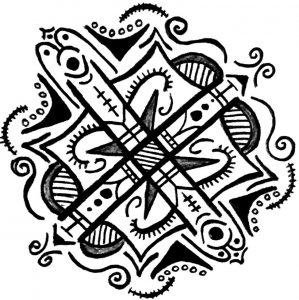We have started the new semester by learning what is mapping. A map is a symbolic depiction of the things such as a visual representation of an entire area or a part of an area.
An aerial photo of the New York City was given and for case 1 – step 1 we were expected to produce an abstract representation of it by pixelating the image and changing the degree of transparency of each pixel according to the repeating and varying conditions inherent to this image.


The image is 25×60 and the pixels are 5×5. While abstracting and changing the transparency levels, our concern should not be related to our perception such as saying there are lakes, parks, roads and buildings. We should perceive the image as saying there are continuous lines; more dense, colored or textured parts etc.
I changed the transparency according to dominance, order and variations of texture. I thought that the middle part of the image, rectangular shaped lake, is the most dominant and ordered the part so I did not change its transparency. Then I increased the transparency levels with this strategy.
For step 2 we were expected to produce a relief out of the pixelated image. Variation and differentiation of conditions which are attained in 2D should be expressed 3D in the form of a relief. In order to introduce depth, we stick layers of cardboard.

I made the most transparent parts are the highest ones. The levels are decreasing when also the degree of transparency is decreasing.
Then we revised this model by using 2,5 x 2,5 pixels to introduce more complex relationships and to break strong grid appearance. I did not make big changes but at some parts, new proportion helped me to describe some parts more accurately.

Finally, we did our models with black cardboard. At my submission model, I did not make any changes. However, I bought a black cardboard which one is more difficult to cut than the other type of it. Therefore, after I finished my model I could not feel my fingers and my model became too heavy.

For the case 2 – step 1 we recomposed the pixelated image considering the transparency level of each pixel. Dimensions of the pixels are again 5×5 but the whole composition is 20×75. While recomposing the pixels, we should not consider the characteristics of the original image but only changes in the level of transparency and try to achieve different conditions of continuities and discontinuities.
We should answer these questions:
- How can you define continuity and discontinuity?
- How can you organize different colored pixels?
- How can you define zones with readable guidelines and without strict and messy conditions? (Breaking certain shape with a rule, making regions with different definitions)

I kept some parts as of how it was at case 1. However, I thought that I could not achieve something promising because I could not define differentiable zones and readable guidelines of continuities which have caused a messy composition. So I did it again.

Again I kept the U shape because I think that it defines both continuity&discontinuity and regions at inside and outside of it. At the rest of the composition, I made some variations of it.
After recomposition for the second step, we were assigned to make a model of it by orthogonally folding some cut outs from a plane which is 20×75.

I have two strange shapes and two rectangle shapes in my model. I fold them through opposite directions to make some guidelines. Also in the manner of 3D, my U shape and big rectangle create a continuity between them while also defining a zone together. The half – U shape and the square is a variation of the other part and keeps the guidelines.
For case 3 we chose and cropped a 20x35cm zone from the pixelated image that we regenerated for the case two. We chose the zone according to the continuities and the discontinuities of the pixels. Then we deleted some pixels from the zone to define new continuities.

I chose the middle part of the image because this part has a U-shape and an L-shape like my main elements of the second case’s model. Then I erased the black part to define the sharper shapes and continuity.
Then we made this zone’s model by cutting out the deleted pixels from a thick, sanded acetate which is 20x35cm. At later stages, we will use it as a transparent glass.

